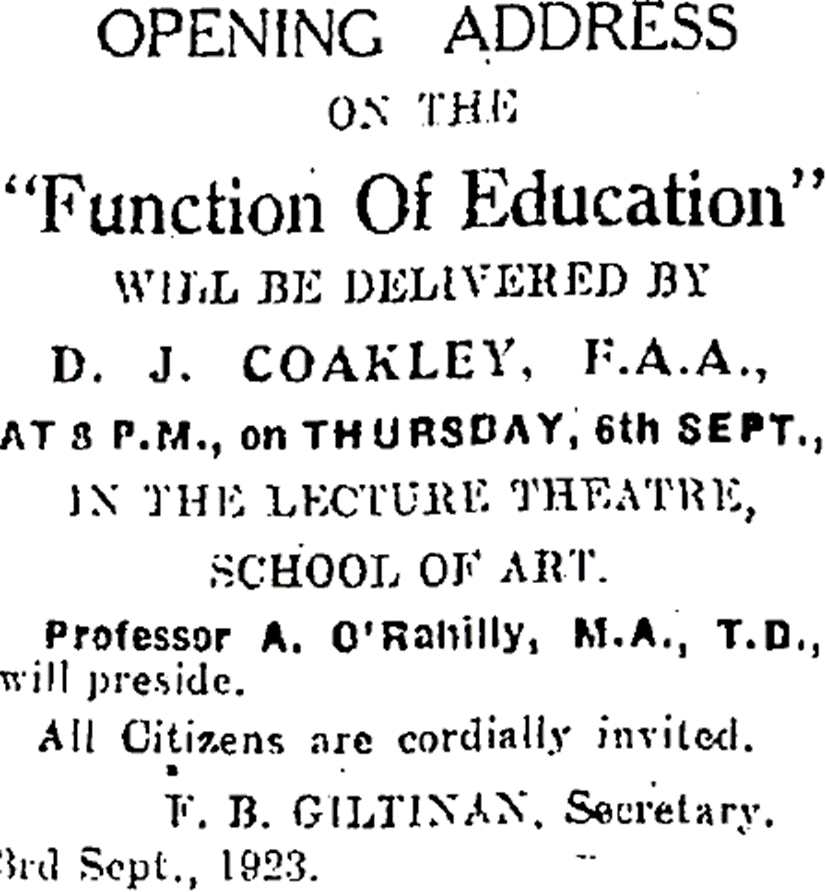Monday 5 November 1923
MUNSTER ART CLUB EXHIBITION – A RESPONSE
‘Sir, - It is to me a matter of astonishment that so little notice has been taken of the work of John [Seán] Keating at the Munster Art Club Exhibition. However one may dislike or disapproved of his technical methods or even of his subject and its treatment (and I know there are many who do), only those whose artistic perceptions are perfectly atrophied could fail to see the force, vigour and individuality of his conceptions; the unwavering pursuit of a preconceived design; and the vitality, energy, the complete and unfaltering aplomb with which the design is carried out to its predestined end.
Here, beyond all doubt, is a new and inspiring force in Irish art and one that, boycott or no boycott, will eventually make itself felt in no uncertain fashion. His chief work, ‘Men of the South’ has an especial interest. Here is historical painting in the only true and vital fashion There are persons, and it is easy to understand it, to whom this picture or any such reminder of the times we are passing through, bring no thoughts but those of repulsion and disgust.
But in art, one must take the long view. This is not the final generation of Irishmen, let us repeat. We may feel certain that ten, twenty, fifty years hence, when the bitter passions, the angry thoughts, the disappointed ambitions that thwarted desires, the friendships, and the ignoble squabblings of these unhappy days have been softened and dissolved by the healing passage of time, and all is seen in its true perspective, this picture will show to Irishmen, once again united by love of Ireland, the real and unquestionable ideal of manly freedom which first quickened the stagnant waters of Irish national life in our days. And it will show this in the most vital and impressive fashion possible – by its passionate earnestness and sincerity, its powerful and unbending sense of finality in judgement, and its unassailable superiority of conception and execution.
When the Germans surrendered in 1918, the English Government, wiser and more experience than we in such matters, employed their foremost artists to paint the tragic scene. For us, the poignancy of that picture [‘Men of the South’] lies in the fact that it was painted by an Irishman, who like Burke, Goldsmith, Sheridan, Shaw, Wilde, Harty, Stanford and hundreds of lesser men, was forced by the poverty of his county to spend his powers on foreign soil, among a foreign people. The artist equally with the labourer, is worthy of his hire.
It has been suggested that this picture should be bought for and lodged in Cork City. Many voices, I know, will be raised against such “extravagance.” The price of it - £250-would enable John Keating to work for six to eight months on a new, perhaps, a better work. Hundreds upon hundreds of pounds are wasted every year in this city in sending out agendas and reports which nobody reads, and nobody wishes to read, and nobody objects to that.
Is it necessary to refer to the [Hugh] Lane Collection and the Dublin Corporation’s contemptuous rejection of a princely gift – an act of folly for which their city is now doing penance in sackcloth and ashes? For once, let somebody or other in Cork display a little public spirit and civic wisdom, and not let this opportunity slip, as so many others have. – Mise le meas mor,
D. Ua Braoin
P.S. – If all else fails, it surely ought to be possible to get together a number of those interested sufficient to raise the necessary money by private subscription and collection.
(Source: Cork Examiner, 5 November 1923, p8)
Wednesday 7 November 1923
MEN OF THE SOUTH - A RESPONSE
CAG.0335 Henry Jones Thaddeus, Portrait of a Gentleman (Michael Holland),1920. Presented, the Artist, c.1920.
‘Sir. – May I be permitted to thank your correspondent D. Ua Braoin, who directed the attention of your readers to the Exhibition organised by the Munster Fine Art Club, now being held in the School of Art. I paid it a visit immediately after reading his letter, and candidly I must say I cannot agree with the suggestion as to purchase by the Municipality of Mr. Keating’s “Men of the South”.
My failing to agree, would not I know justify inflicting myself on you, were it not for the fact that with an election pending. Heaven only know to what length corporators may go in vote-catching and a word in season may be advisable.
“The Men of the South” is evidently meant as a companion picture to the same artist’s “Men of the West”. A group of five or six young men armed with rifles and revolvers have posed themselves – and their weapons – and the result is only an enlarged photograph “hand painted”. One can see a dozen similar groups in a photographer’s window in McCurtain [sic] Street any day, with only the difference of a uniform. There is the usual stilted photograph pose. The men are gazing at some object, so far away that there is no appearance of any immediate intention of using the rifles, yet the leader sits with his finger on the trigger of his revolver!
It may be a good portrait group but if we want such a group for Cork city we have men in our own whose names will live in history and whose portraits would fitly adorn any City Hall which we may build. We have also in Joseph Higgins a portraitist whose excellent work is one of the outstanding features of the Exhibition, and who is at least as worthy of our encouragement as Mr. Keating.
I have written the above with diffidence, as one who is neither an artist, nor an art critic, but when it is suggested that the city should spend its money in any particular direction, the ordinary man-in-the-street is entitled to a word in the matter. I may perhaps add that it the Corporation or even a group of citizens has any money to spend on art, they can secure for about £130, four of Michael Holland’s* delicate little water colours, those two weird conceptions of Nellie Welphy, Wilkie’s “Portrait Studies”, Dermot O’Brien’s “Dinner Hour”, De Vere Smith’s “Sketch”, Joseph Harty’s “Book of Verses,” and finally the single portrait of Higgin’s which is for sale as his three sculptures. It is high time that some of our own prophets had honour in their own country.
Yours, etc, D.O.D.
(Source: Cork Examiner, 7 November 1923, p8)
*Michael Holland (1855-1950) was a topographical artist and illustrator who was born in Clonakilty, Co. Cork and was, for many years, one of the ‘outstanding historians of Cork City and an expert authority on the life and growth of the city since earliest times’.
‘He was the father of the late Mrs Joan Brunicardi, M.A., who pursued a brilliant course in Archaeology at University College Cork, and Miss Catherine Holland, artist and illustrator of the College of Arms, London, some of whose work has been incorporated in the ‘Battle of Britain’ window at Westminster Abbey.
Michael Holland had attended classes at the Cork School of Art and showed ‘outstanding talent’.
In 1875 he was a twenty-year old boardroom clerk at James Dwyer’s company. Alderman Dwyer was connected with the reception and entertainment of John Mitchel**, who arrived unwell in Cork City. Holland made a small drawing of him when he was confined to bed. An admired example of Holland’s work was the illuminated address presented to Charles Stewart Parnell (1846-1891).
He was an ‘indefatigable collector of rate artistic glass, china, books and other objects, and at one time possessed a veritable museum. Amongst the articles which he possessed was a drawing desk which belong to Sir Joshua Reynolds, the famous English artist (acquired at one of the sales at Rostellan Castle, where it had come owing to the relationship by marriage of one of the O’Brien’s to Reynolds heiress).’
An expert in lace-making he was also a founding member of the Cork Historical and Archaeological Society it his obituary in Cork Examiner, it was noted that ‘No man made a closer study of everything that appertained to the City of Cork. No man could have been more generous about the information he laboriously acquired. Every stranger coming to Cork in search of family history or other details was usually referred to Mr. Holland, who was always willing to share his personal knowledge or to put the inquirer on the right track for getting what was wanted.’
During the latter years of his life he wrote and created illustrated historical strips which appeared
Regularly in the Cork Examiner and the Cork Weekly. The Cork City Library holds more than 200 of the originals. His passing was described by the Cork Examiner as creating ‘a void in the life of Cork, which will be impossible to fill’.
(Source: Cork Examiner, 7 November 1950, p4 and Theo Snoddy, Dictionary of Irish Artists 20th Century, second edition, Merlin, 2002)
**John Mitchel (1815-1875) was a lawyer, polemicist, newspaper editor and Irish Rebel - See Thomas Keneally’s compelling book Fanatic Heart, published 2022, Random House or History Ireland.
Thursday 8 November 1923
MEN OF THE SOUTH – A FURTHER RESPONSE
Photo: Marcin Lewandowski
(Source: Cork Examiner, 8 November 1923, p2)
‘Sir – I have just read in the “Examiner” a letter from Mr. Ua Braoin (link to 5 November Blog please BARRY) complaining that the works of John [Seán] Keating at the Munster Art Exhibition have not received sufficient appreciation. If such be the case, I can only say that Keating’s work will stand on its own merits among those who profess to know more about the art of painting that that of writing art critiques in newspapers.
We have seen those pictures of Keating’s at the Exhibition and carried away our impressions in our own hearts without a thought of giving publicity to them; but since this letter has appeared and the suggestion is made that a picture should be bought by the city, it is not amiss, I think, for art lovers to express an opinion.
In the first place, if a picture – of El Grico [El Greco 1541-1641] let us say – were to be hung for the first time in our School of Art, and some crank were to suggest it should be purchased by the Corporation, I have no doubt it would be disdainfully rejected on technical grounds by our municipal experts. Moreover, I do not say they would be wholly wrong – I would merely suggest that they had detected what was wrong with the picture, and ignored what was right and great and overlasting.
All art is but a “seeking after the truth”. Whether this truth take a humorous, a vulgar, or a subline form is immaterial, and to come near to achieving perfection in a conception of vulgarity is better art than failing utterly in a sublime motif. By the word “vulgar” I mean to express something “crude or unrefined”, not “indecent or revolting,” as it might possibly be interpreted by some.
The Frenchman Rabellais [François Rabelais (d.1553)], clothed his vulgarity with a certain artistic touch, which the Anglo-Irishman Charles Lever [1806-1872], failed to accomplish; and in the art of John Keating we feel a sense of truth and directness which gives him an individuality well marked as a painter.
Some of the works in the Exhibition impress one with their magnificent ranting vulgarity! Keating’s “Stage Irishmen” one might ask [‘Men of the South’]. Certainly not, they are “Keating’s Irishmen” if you like, but real Irishmen – not built upon vulgar conventions.
Let John Lavery retain his place amongst the elite, painting portraits in academic style of popular Irish statesmen and politicians, of whose existence, I should venture to say, he was hardly aware until a certain much abused Treaty was ratified. We do not grudge him the frame of a Romney or a Gainsborough, but we rejoice in our hearts that we have our Hogarth too – a seeker after truth in wayside places, with a feeling for local colour, which impels one to couple his name with that of Jack Yeats.
If the choice were mine of selecting either a portrait of Lavery – for instance that of John Redmond or Sir Edward Carson in the Harcourt Street Gallery – or one of Keating’s recent works, I am afraid I should back my judgement on “Barney who backed the winner.” I should do so in spite of the sneers of the academicians, believing with the old poet and philosopher that:
“One glimpse of thee within the tavern caught,
Better than in Mahomet’s Temple lost outright”*
I am willing to give my support to the suggestion of Mr. Ua Braioin, for, in my poor judgement, the name of John Keating will live in Irish art.
Yours faithfully,
W.H. McDonnell
Castlelack, Bandon, Co. Cork
(Source: Cork Examiner, 8 November 1923, p2)
*quoted from the Persian polymath Omar Khayyan’s (1048-1131) poem ‘Rubaiyat of Omar Khayyam’ translated into English by Edward Fitzgerald in the 19th century and became immensely popular.
Friday 16 November 1923
FIRE IN CORK AT PUNCH & CO
(Image from Cork Examiner, 5 July 1924, p3)
‘About 4.45 last evening the Fire Brigade were called to the premises of Messrs. Punch and Co., Academy Street. On arrival it was found that a small fire was caused by the fusing of an electric wire. The flames, however, were extinguished with a chemical engine before any material damage was done.’
(Extract from Cork Examiner, 17 November 1923, p9)
Monday 19 November 1923
(Image from Cork Examiner, 5 July 1924, p3)
George Atkinson’s lecture was the last in a series of public lectures organised by Cork School of Art during 1923 which included its own teaching staff:
- Gladys Scott ‘Nature and Imagination in Art’
Design Teacher
- John Power ‘The Construction of a Picture’
Second Art Master (or Vice Principal)
- Michael Holland ‘Sketches of Irish Artists’
Guest Lecturer, Botanist and President of Cork Historical and Archaeological Society (1942-46)
- Hugh Colman Charde ‘Sketch of [James] Barry’s Life’
Artist and Principal, Crawford Municipal School of Art
- Daniel Corkery ‘What an Irish School of Art Should Be’
Writer, Teacher, Artist, and Gibson Bequest Sub-Committee Member
- John Joseph O’Connor ‘Art and Craftsmanship’
Technical Instructor and Administrator, and Gibson Bequest Sub-Committee Member
- George Atkinson ‘Post Impressionism’
Artist and Principal, Dublin Metropolitan School of Art, and Expert Advisor to Gibson Bequest Sub-Committee.
Tuesday 20 November 1923
GEORGE ATKINSON R.H.A. LECTURE AT SCHOOL OF ART
A REVIEW
Magic Lantern with glass slides c.1920. Image open source.
‘A lecture, dealing with a well-considered analysis of the more extreme tendencies in recent modern art, was delivered by Mr. G. Atkinson, R.H.A., at the School of Art.
He dealt with the characteristics of preceding forms in order to establish a connection with present activities, and to show whether these activities were merely isolated eccentricities or abnormalities that might be disregarded as wholly transitory and negligible.
He said it was customary to assume that the art of painting progressed though the growth of knowledge and research, and attained full perfection, by gradual improvement, in each succeeding stage. He [Atkinson] preferred to regard the evolution of painting, not as progression to a perfection, but to a series of perfections. It was the belief in many quarters that the modern tendencies appearing in art were due to the abnormal and disintegrating conditions arising our of the war.
Others maintained that they constitute a form of Bolshevism in art, without really understanding the nature of Bolshevism, except as something revolutionary and distressing. There was no doubt that the war did much to accentuate the note of violence and the vividness apparent in some of its aspects, but the war could not be the originating cause, as the seeds of the movement as a whole were sown during the latter years of the nineteenth century.
He fixed the year 1900 as the year when the modifications taking place in the work of certain painters of the Impressionist School first resolved themselves into the definite movement which later became known as Post Impressionism. The chief aim of the Impressionists was to paint the effect of light and atmosphere at a given movement, but they made a distinction between casual vision, with its associations and memories, and observation in the strict sense of the term.
A later development arising out of Impressionism, and known as Division, consisted in the application of scientific theories of colour to the art of paintings. To three artists, contemporary with, and for a time actually following the methods of Impressionism and Divisionism: the origins of all the subsequent tendencies could be attributed. These three were Paul Cezanne, Vincent Van Gogh and Paul Gauguin, and each might be said to have become tired of Impressionism and to have developed tendencies that were no longer compatible with the guiding principles of the Impressionists.
Cezanne’s most profound characteristic was insistence upon structure, volume and mass of things, and he sought to obtain these qualities by an emphasis of the planes and structural lines. Cubism arose out of an exaggeration of the angularities of the treatment of form adopted by Cezanne. Van Gogh emphasised a regard for the actual importance of the paint in handling and the value of vivid imagination. Gauguin’s chief characteristic was pronounced decorative arrangement and a strong sense of rhythm in his drawing.
The lecturer concluded by showing examples of the work* of Irish artists:- William Orpen, John [Seán] Keating, Jack Yeats, and O’Rorke Dickey – in which he observed important qualities traceable to the influence of the modern modes.
Mr. D [Daniel] Corkery (Vice-Chairman Sub-Committee, School of Art) who presided, called on the Deputy Lord Mayor Councillor William Ellis, to propose a vote of thanks to the lecturer, to which the lecturer [George Atkinson] fittingly responded.’
(Extract from Cork Examiner, 21 November 1923, p3)
*Lectures were illuminated by ‘Magic Lanterns’ which was an early type of ‘projector’. Using an electrical light source printed or hand painted images on glass slides would be illuminated through a concave mirror behind the light source and onto a lens at the front of the apparatus. The lens then was adjusted to focus the image onto the wall or projection screen forming an enlarged image of the slide onto the screen.
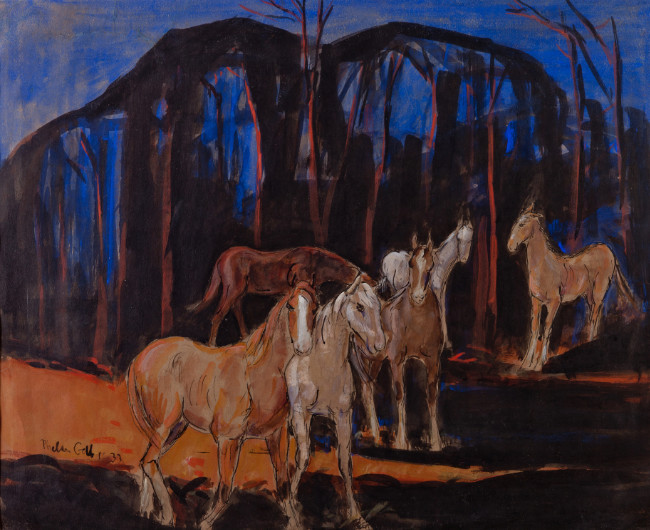


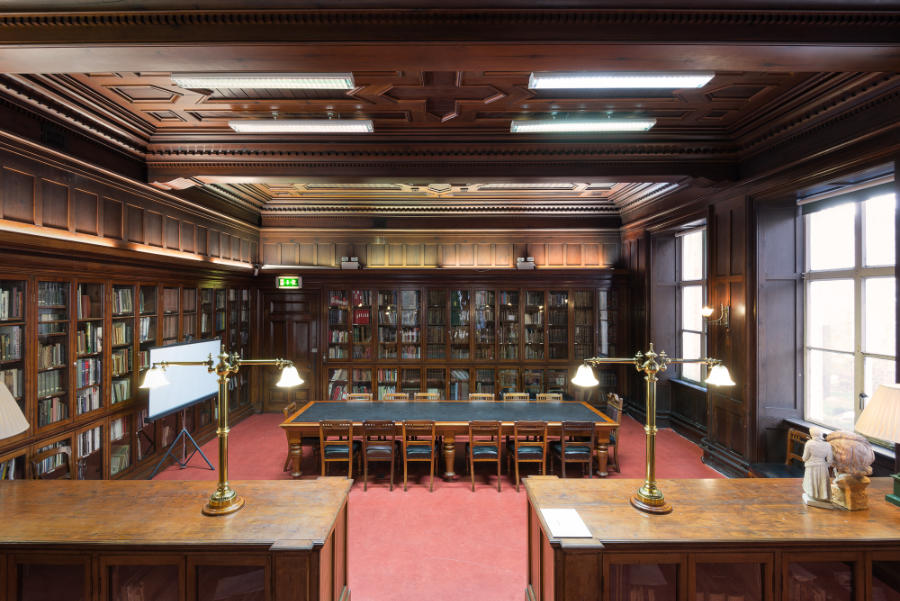
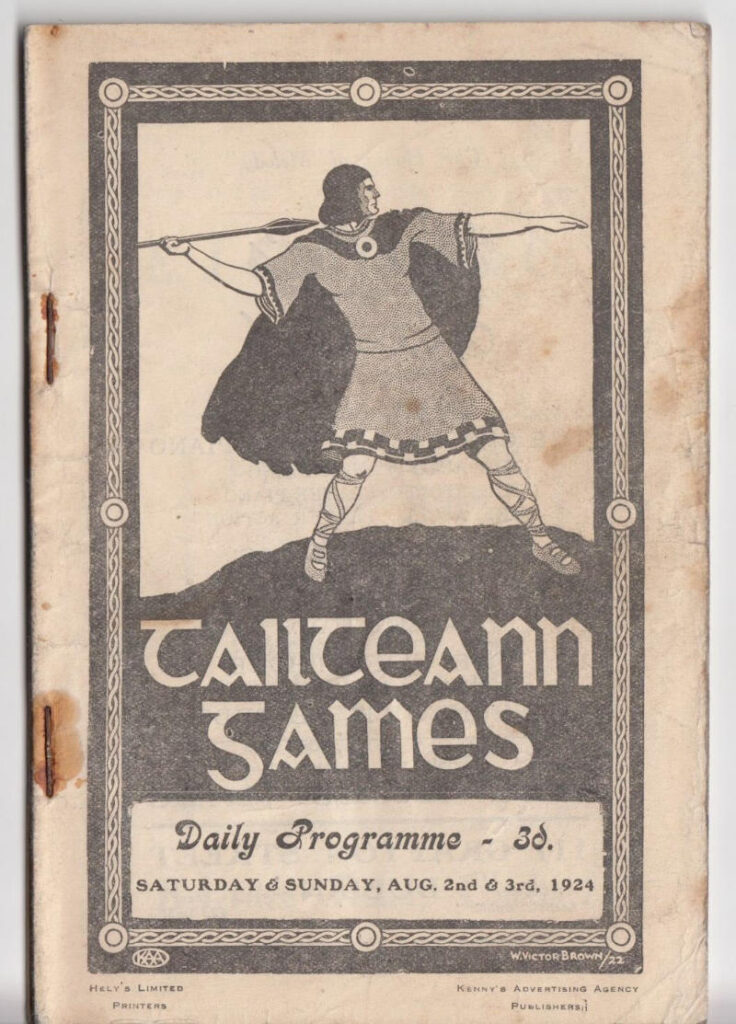
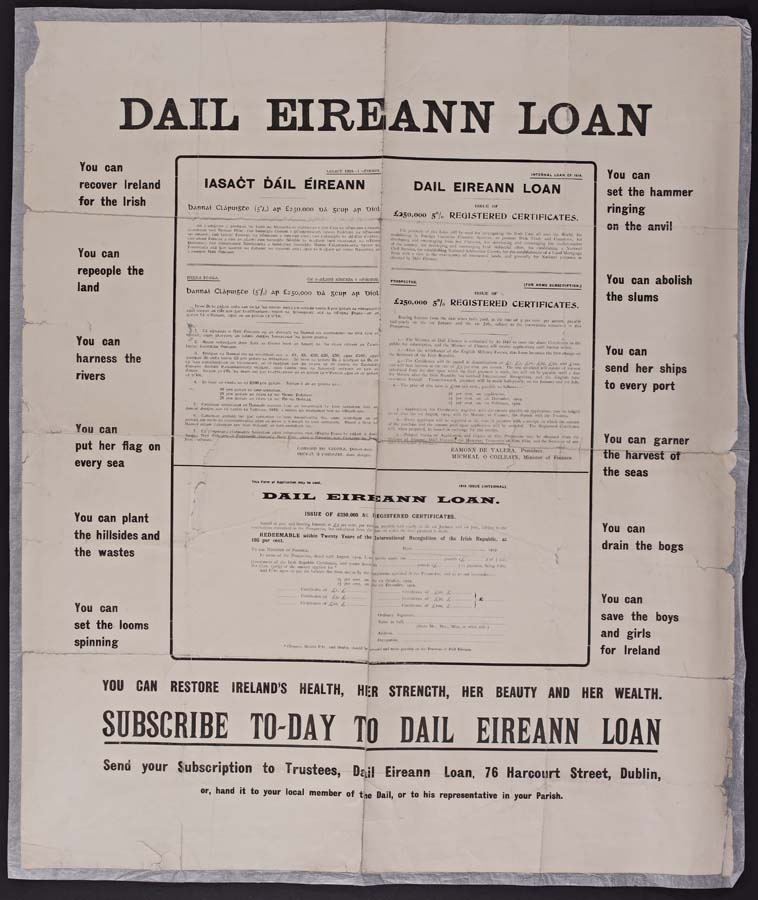
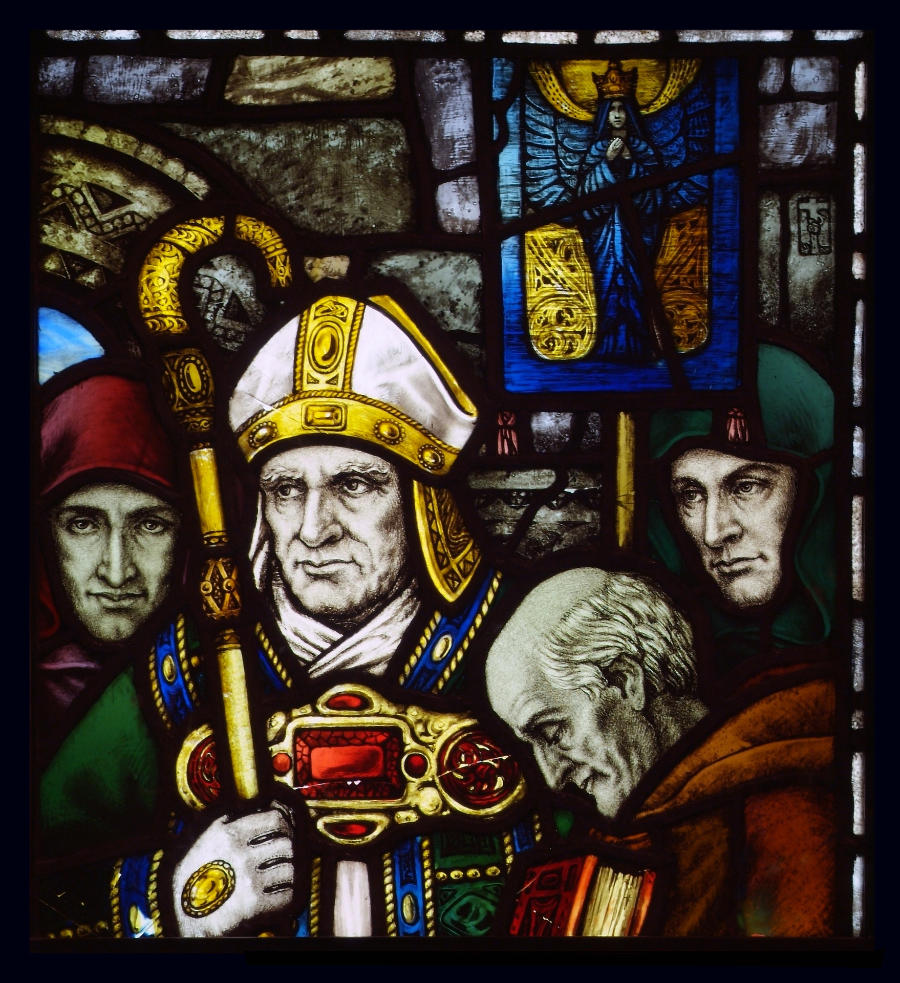
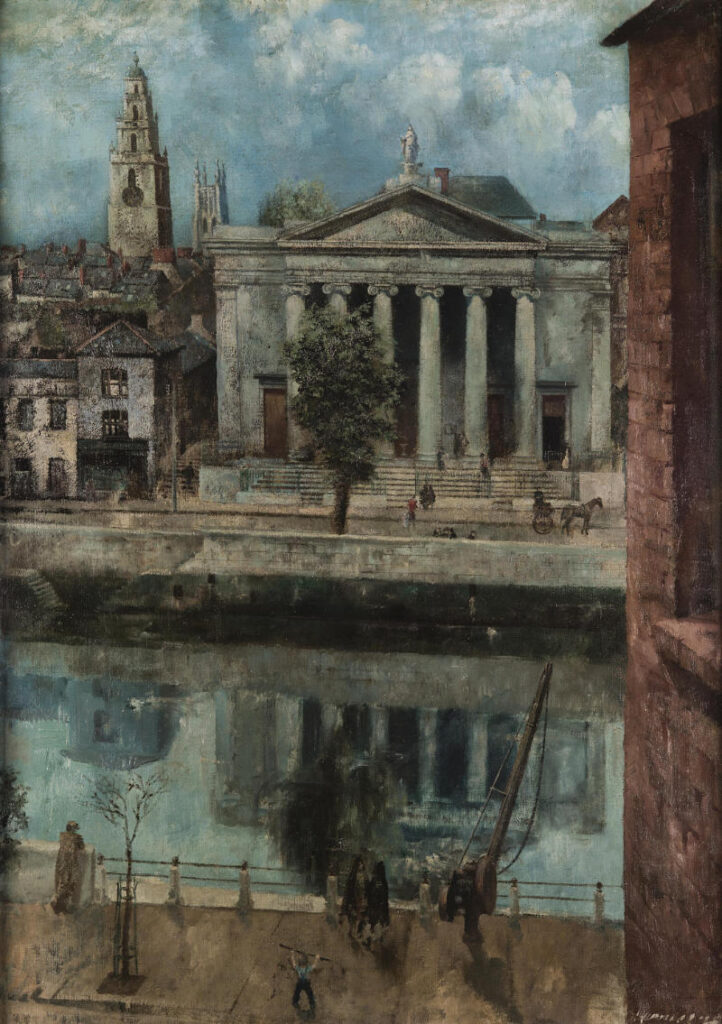

![[Source Cork Examiner 12 December 1923, p4]](https://crawfordartgallery.ie/wp-content/uploads/19231220_Image.jpg)



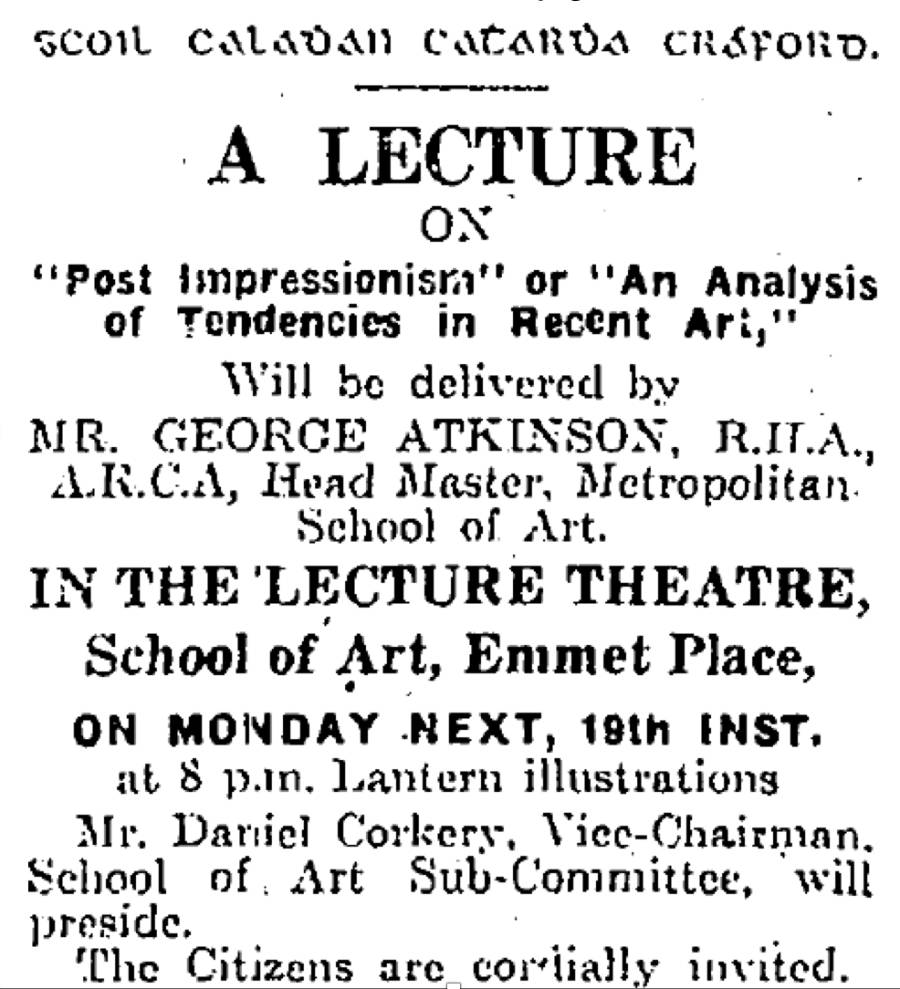
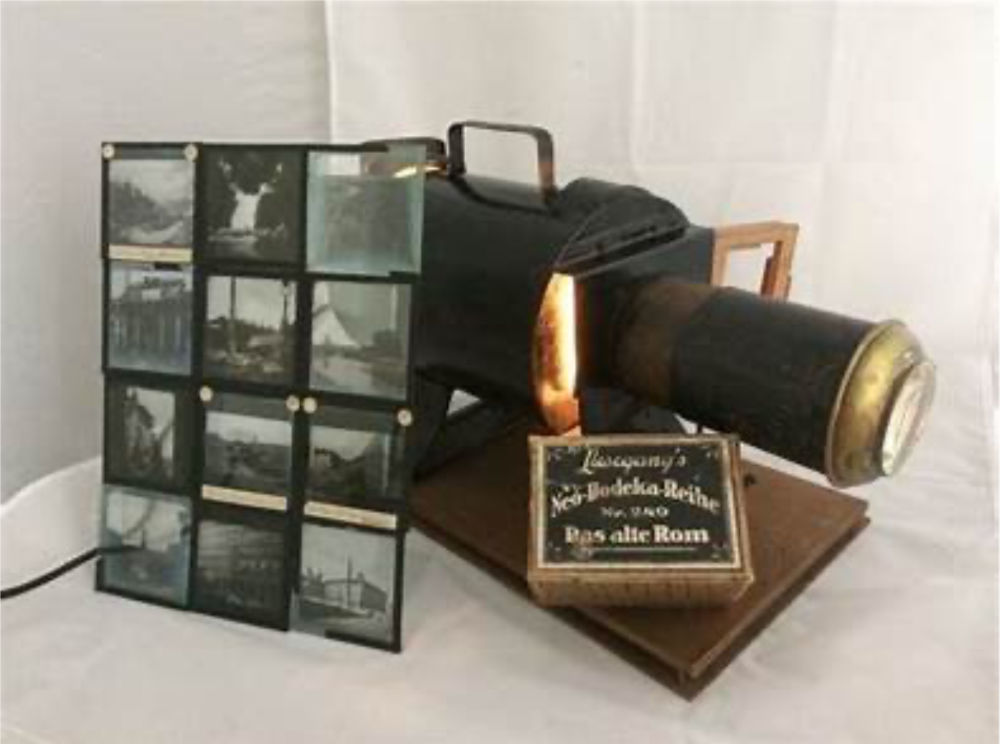
![[extract: Cork Examiner, 22 October 1923, p6]](https://crawfordartgallery.ie/wp-content/uploads/19231022_Image_MunsterFineArtClub_TicketAdvertIEx.jpg)
